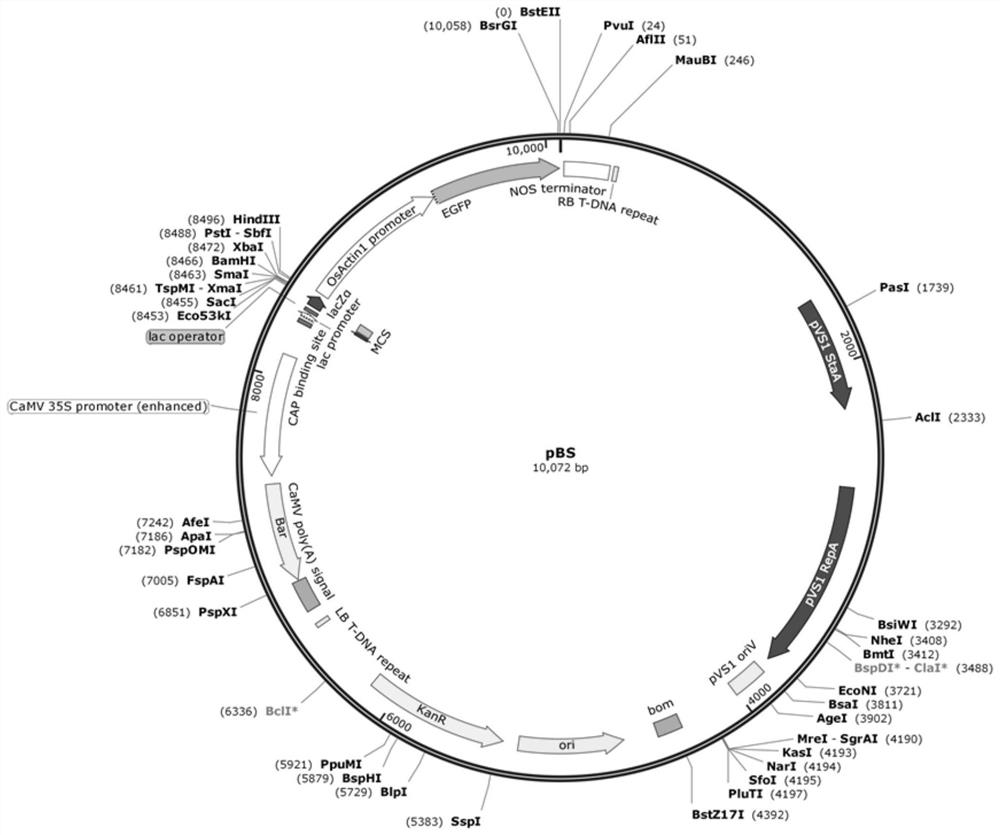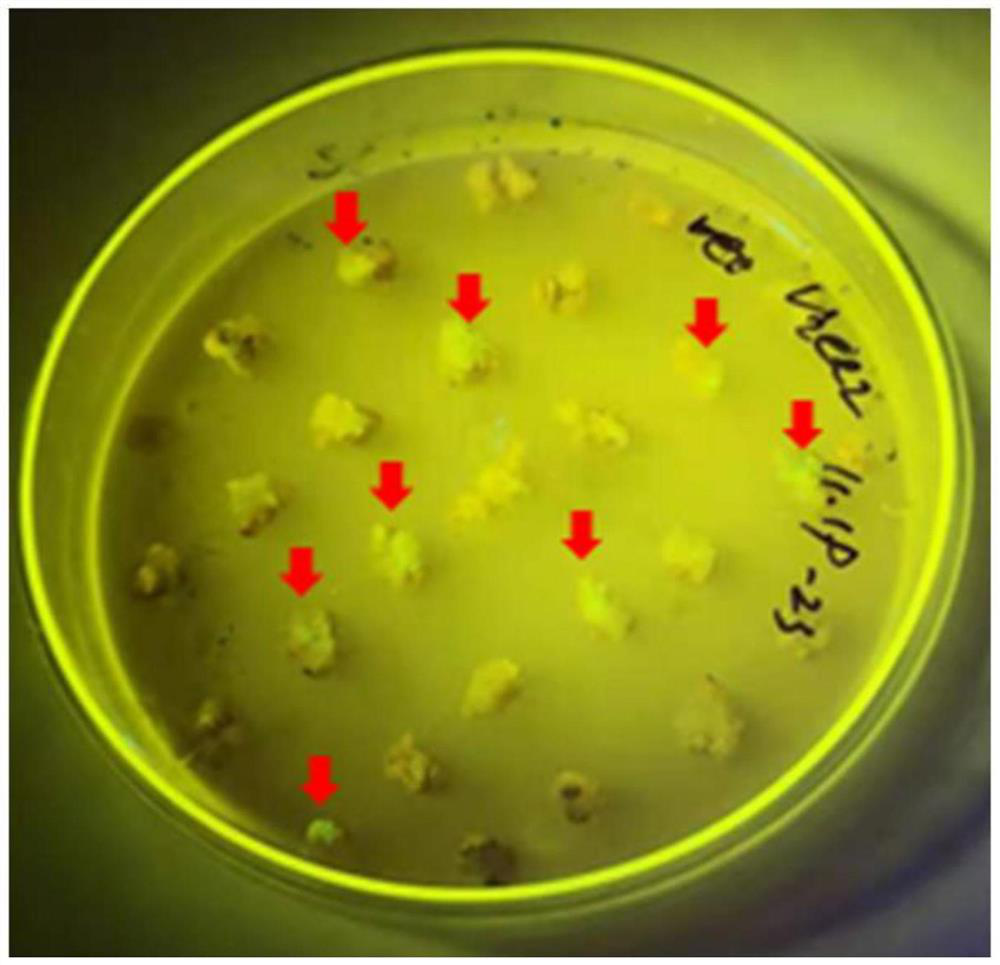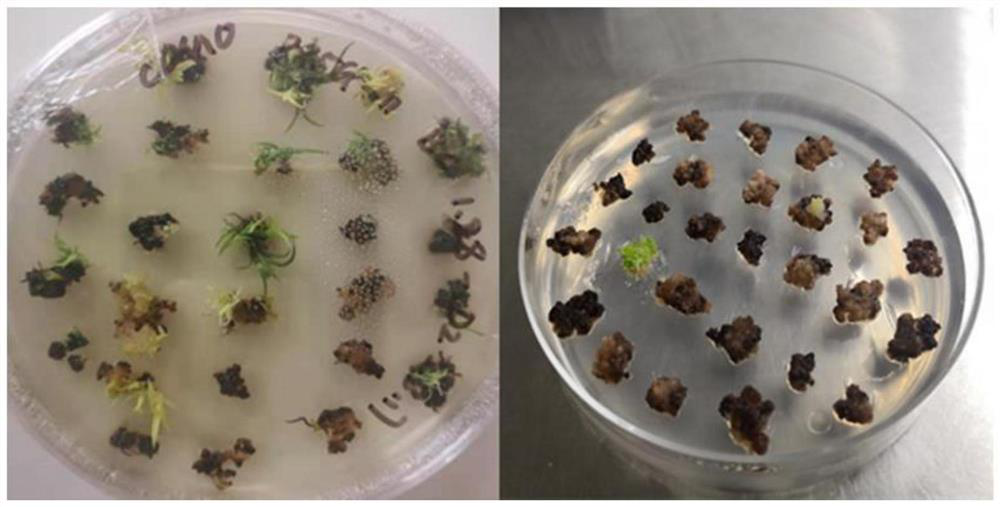Agrobacterium tumefaciens-mediated sugarcane callus efficient genetic transformation method
A genetic transformation method, Agrobacterium-mediated technology, applied in the field of high-efficiency genetic transformation of sugarcane callus mediated by Agrobacterium, can solve the problems of difficulty in improving the overall transformation efficiency, plant callus damage and death, increased workload, etc., to achieve improved The effects of survival rate and differentiation ability, improvement of bacterial transformation activity, and improvement of accuracy
- Summary
- Abstract
- Description
- Claims
- Application Information
AI Technical Summary
Problems solved by technology
Method used
Image
Examples
Embodiment 1
[0042] Step 1, sugarcane callus induction:
[0043] Take sugarcane (respectively use sugarcane cultivar (Saccharum spp.hybrid) ROC22 and Yuncane 05-51 two varieties) 1-5cm section (preferably 3cm) above the top growth point, peel off the outer mature leaves layer by layer, and work in ultra-clean The surface of Taichung was disinfected by spraying alcohol, and the inner diameter of 1cm young leaf rolls was collected, cut into 1-2mm (preferably 1mm) thick leaf discs, and inoculated into callus induction medium. The cells were cultured in the dark at 28°C, and subcultured once every 2-3 weeks (preferably 2 weeks). Those with dry surface, firm texture and white to light yellow color were used for genetic transformation.
[0044] The above-mentioned callus induction medium was MS+2,4-D 3.0mg / L+sucrose 30g / L+agar powder 8.0g / L, pH 5.8, sterilized by high pressure moist heat at 121°C.
[0045] Step 2, construction of EGFP-Bar double marker screening system and transformation of en...
Embodiment 2
[0068] Step 1 is the same as Step 1 of Embodiment 1.
[0069] Step 2 is the same as Step 2 of Embodiment 1.
[0070] The difference between step 3 and step 3 of Example 1 is that the dip-dyeing medium is 1 / 2MS+2,4-D 3.5mg / L+sucrose 20g / L+glucose 10g / L+AS 40mg / L, pH 5.2.
[0071] Step 4, sugarcane callus intensified dip:
[0072] The sugarcane callus was cut to a size of 5mm, the surface was dried, and then transferred into the infusion solution for intensive infusion. Tween-20 with a volume ratio of 0.1% was added, incubated at 28° C. and 100 rpm in the dark for 15 min, followed by 40 kHz ultrasonic water bath for 10 min at room temperature, 44 kPa vacuum treatment for 5 min, and dark for 5 min.
[0073] The difference between step 5 and step 5 of Example 1 is: CCM medium is 1 / 2MS+2,4-D 2.0mg / L+citric acid 300mg / L+sucrose 20g / L+glucose 10g / L+AS 20mg / L, pH 5.2.
[0074] The difference between step 6 and step 6 of embodiment 1 is:
[0075] CSM medium is MS+2,4-D 2.0mg / L+citri...
Embodiment 3
[0079] Step 1 is the same as Step 1 of Embodiment 1.
[0080] Step 2 is the same as Step 2 of Embodiment 1.
[0081] The difference between step 3 and step 3 of Example 1 is that the dip-dyeing medium is 1 / 2MS+2,4-D 3.0mg / L+sucrose 15g / L+glucose 15g / L+AS 40mg / L, pH 5.2.
[0082] Step 4, sugarcane callus intensified dip:
[0083] The sugarcane callus was cut to a size of 4 mm, the surface was dried, and then transferred into the infusion solution for intensive infusion. Tween-20 with a volume ratio of 0.1% was added, incubated at 28° C. and 100 rpm in the dark for 10 min, followed by a 40 kHz ultrasonic water bath for 5 min at room temperature, 32 kPa vacuum treatment for 10 min, and a dark stand for 10 min.
[0084] The difference between step 5 and step 5 of Example 1 is: CCM medium is 1 / 2MS+2,4-D 2.0mg / L+citric acid 250mg / L+sucrose 15g / L+glucose 15g / L+AS 20mg / L, pH 5.2.
[0085] The difference between step 6 and step 6 of embodiment 1 is:
[0086] CSM medium is MS+2,4-D...
PUM
| Property | Measurement | Unit |
|---|---|---|
| concentration | aaaaa | aaaaa |
Abstract
Description
Claims
Application Information
 Login to View More
Login to View More - R&D
- Intellectual Property
- Life Sciences
- Materials
- Tech Scout
- Unparalleled Data Quality
- Higher Quality Content
- 60% Fewer Hallucinations
Browse by: Latest US Patents, China's latest patents, Technical Efficacy Thesaurus, Application Domain, Technology Topic, Popular Technical Reports.
© 2025 PatSnap. All rights reserved.Legal|Privacy policy|Modern Slavery Act Transparency Statement|Sitemap|About US| Contact US: help@patsnap.com



